Written by Daniel – If you haven’t read my post ‘Protecting Earth-Chan: Anthropomorphism of Astronomical Objects in Fan Art and Bodies‘, I recommend that you check it out. I’ll be continuing my exploration of the planetary ‘Chans’. These ‘Chans’ depict our solar system, the characters are original characters (meaning that they do not come from any existing copyrighted franchise, rather a love for an artistic style combined with a love for astronomical objects and bodies). The characters are inspired by a tweet posted by Trinimomortal, who proposed the idea of a show in which all the characters are the planets anthromorphised as school girls. The idea blew up among anime online communities, inspiring a hole host of fan art, videos and cosplay. What is perhaps most interesting about this community (from my perspective at least) is how these fan creators have agreed upon a consistent style, common narratives, and will see characters evolve and relationships change in response to news stories and scientific findings of the solar system and the universe beyond.
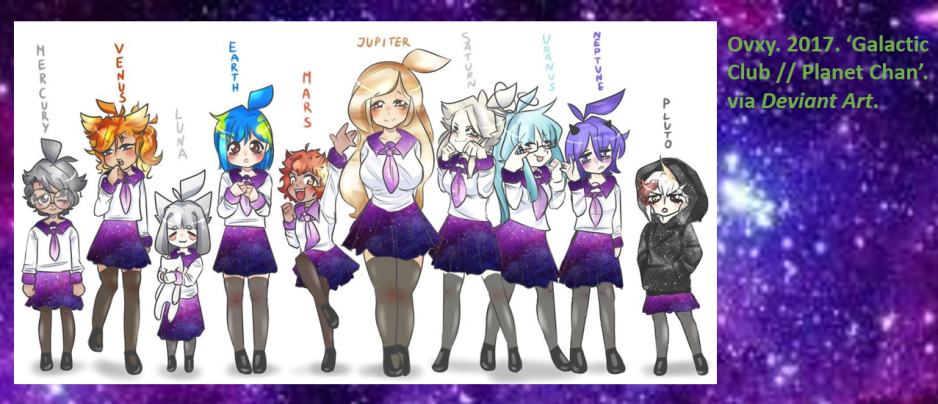
This post is an adaptation of the talk ‘Astronomical Objects and Bodies’ which I presented at Keele University’s ‘Creative and Applied Research Methods’ conference (2019). The purpose of the talk was to show some of the connections between the arts and the sciences, and how fan artists might show academics new methods of engaging with audiences. I open by looking at Gustav Holst’s The Planets, before swiftly moving onto the creativity of anime fans, arguing these fans to be a much more productive and culturally important discussion of the solar system, how we look after our own planet, as well as how we express ourselves to each other.
Composed between 1914-16, Gustav Holst’s The Planets is a suite influenced by astrological mythology rather than astronomical sciences. Earlier this year, Brian Cox hosted the centenary performance of The Planets. In this performance Cox discussed how our current understandings of our solar system and the universe might still be found in Holst’s work. Cox asks how we might interpret The Planets differently to how it was originally written, to investigate what discussions can be had between science and art? I intend to do similarly here, but instead of looking to the high art of Holst, I propose that fan communities are an important cite engaging with such discussion. So let’s begin where Holst does, on the Red Planet. The planet of war. The planet Mars.
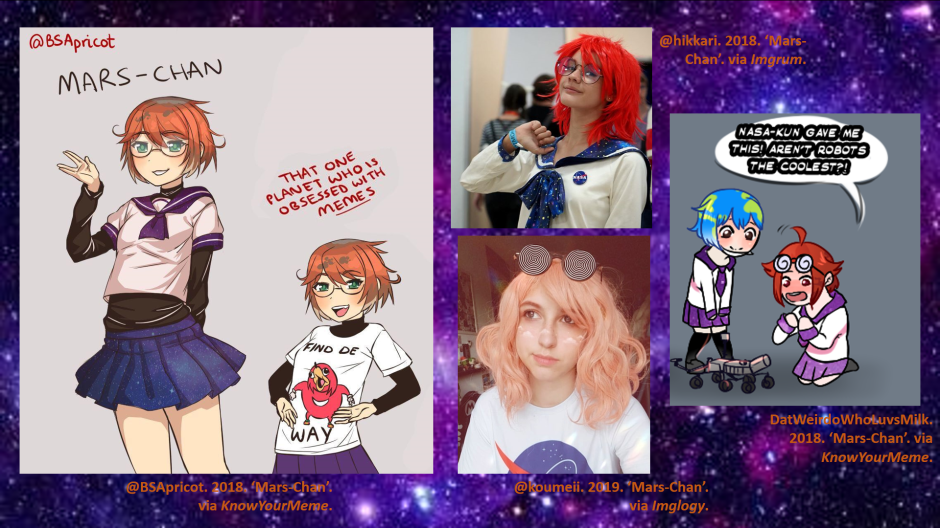
Named after the Roman God of War, a militant thunder is captured in Holst’s retelling of the planet. In Brian Cox’s centenary performance of The Planets, he suggests that we might look to Mars as, not of a place of war and destruction, but a place of opportunity. There is evidence of rivers, and research is being done into proving whether or not Mars used to host life, furthermore, there is a real possibility that one day Mars might be a second home for humanity. Cox asks whether this sense of hope and opportunity can be found in Holst’s work. Personally, I don’t think it can. The music is far too militant, written under vastly different contexts, there is simply too much attention placed on mythology, and what sciences the piece may have been based on is out of date. But, Mars-Chan might just be able to shed some more light on the planet. Mars-Chan is smart, a little shy, and obsessed with her pet Rover. The character’s intelligence is symbolic of the research being done on Mars, combined with her shyness, she is a planet with undiscovered histories, we on Earth are yet to uncover. The characters intelligence and ‘nerdy’ characteristics are emphasized further by her pet Rover, this of course refers to NASA’s Opportunity and Curiosity rovers. The opportunity rover is of course another object which has been humanized by fan artists as I discussed in greater detail in my previous blog post: Protecting Earth-Chan. On 13th February 2019, NASA declared that the Mars Opportunity mission was over. The rover had lasted 14 years and 46 days (55 times longer than its predicted lifespan), subsequently, online artists payed homage to Opportunity in illustrations and comics. Let’s now move on and make our way to Venus.
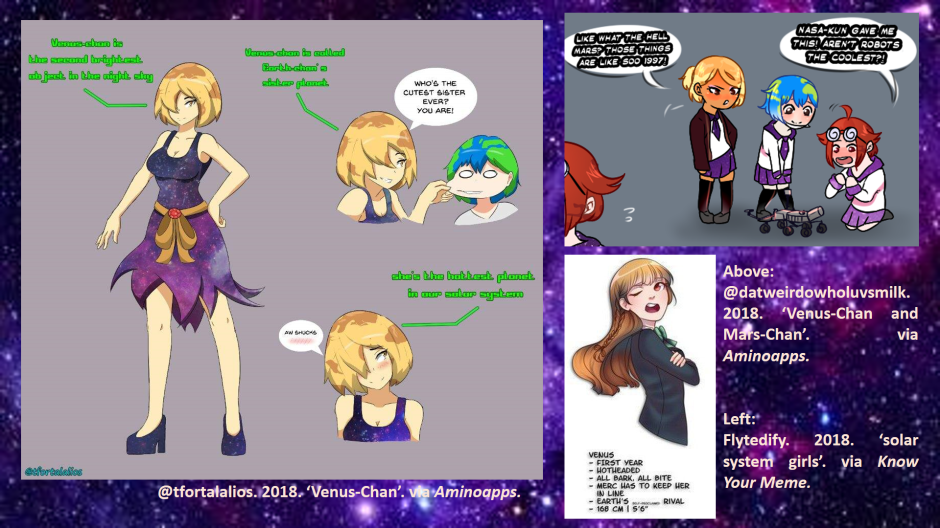
Holst imagines Venus as the bringer of peace in line with Roman mythology, named after the goddess of love and beauty. This is captured in Holst’s slow, one might even say fragile composition. In fact during the period in which Holst would have been composing The Planets, it was thought that Venus may potentially host life. It was only in the 1960’s when closer examinations of the planet were possible when speculation of life on the planet decreased. Venus’s close proximity to the sun results in an extreme greenhouse effect, temperatures on the planets surface are at approximately 462 degrees Celsius. Whilst Mercury is closer to the sun, the composition of Venuses atmosphere makes the planet the hottest in our solar system. As a result, fan artists have kept in line with the planet’s mythology, by representing Venus-Chan as the most sexually attractive member of the solar system girls, or as the ‘hottest’ planet. The planet is known as Earth’s sister planet as it is a similar size to Earth, this relationship is depicted literally in fan art and comics, reflected primarily through competition. Venus is an incredibly dangerous planet (in many ways Holst’s composition for Mars would have been far more appropriate for Venus and vice versa). It’s atmosphere is made up of more that 96% carbon dioxide and its geography consists of 80% smooth volcanic plains. This is not a place to holiday, the uninhabitable landscape is replicated by fan artist’s itterations of Venus as rude and obnoxious as she can be seen insulting Mars-Chan and her Rover (in datweierdowholuvsmilk’s illustration), or in how Venus-Chan considers herself better than her sister Earth-Chan (as seen in @tfortalalios’s iteration of the character). But, let’s jump now to Jupiter.
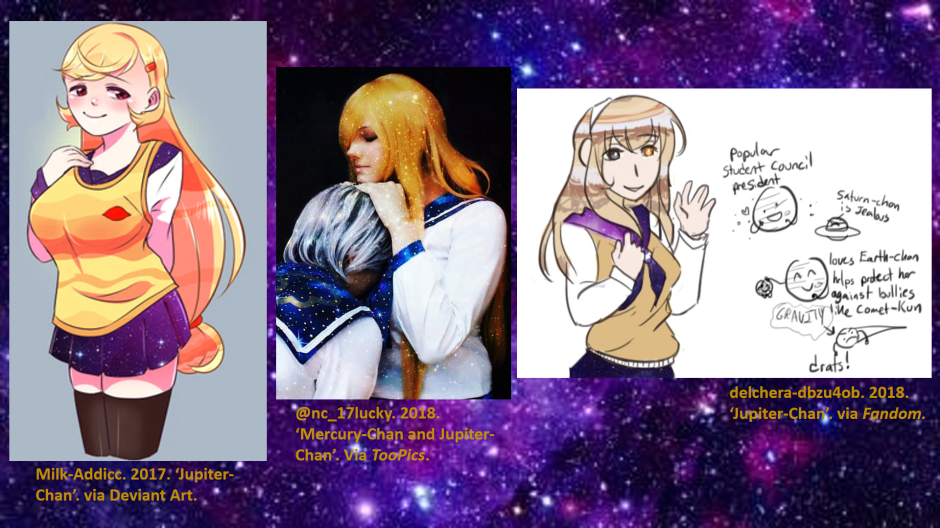
For Holst, Jupiter is the bringer of Jollity. The largest planet in our solar system, it spans fully 11 Earths and is well over 150 times the mass of all the terrestrial planets (Mercury, Venus, Earth and Mars). Holst captures the grandness of Jupiter’s size in the sweeping exploratory feel of his work, before moving onto a much more merry composition, which captures a playful call and response between the brass and wind sections. Fan artists and cosplayers have similarly depicted Jupiter-Chan as the largest of the Chans, but she is a character motivated by caring for her peers, a character of motherly affection above that of frivolous jollity. She is the most caring member of the group and always looks after the smaller planets. Describing Jupiter as a popular planet is rather apt, orbited by 16 moons (four of which are planet sized), Jupiter is surrounded by ‘little ones’. In nc_17lucky’s cosplay of Jupiter-Chan, she is seen giving Mercury-Chan a caring hug, and in delchera’s illustration to the right, Jupiter-Chan is described as a protector of Earth-Chan as she stops the “comet-kun bullies” from picking on her. Jupiter-Chan is the protector on account of the planets extraordinary gravitational pull, which diverts asteroids and comets towards itself and its moons. Fan artists have interpreted Jupiter as taking the punches to protect her peers. Jupiter’s moon Callisto, for example, is more cratered than any planetary body, more so than Mercury. We move now onto Uranus.
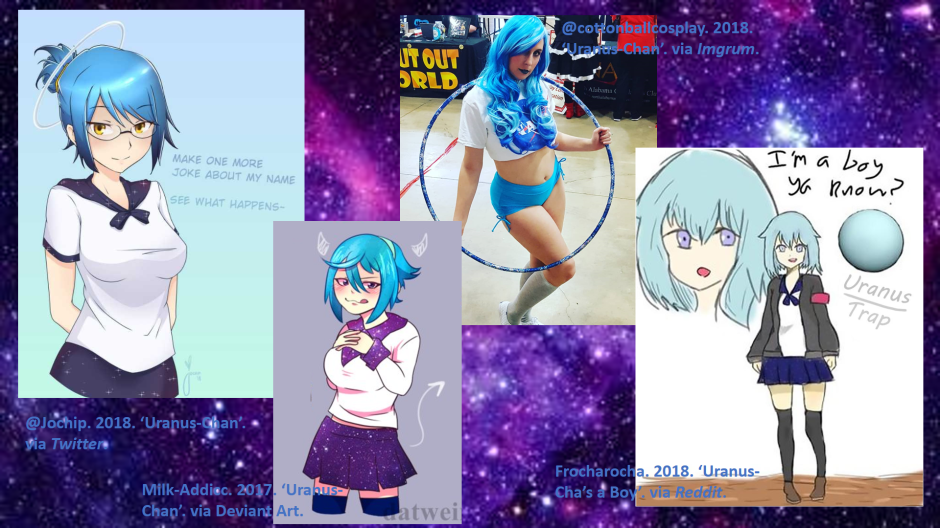
Holst would have known very little about Uranus. Discovered in 1781, the planet is so far away that it is only since 1986 when NASA’s Voyager 2 provided a much clearer view of the cold distant world. For Holst, Uranus is the magician, a planet of wondrous curiosities which is conveyed through a mixture of intense power and harlequin chaos throughout the piece. Uranus-Chan is a cold hearted prankster. Fan Artist Milk_Addict (via DeviantArt) writes that “She’s perverted, ice cold, and the bully of the group”. Uranus is indeed a very strange planet. It has no solid surface, rather it is a fluid blob, made up of smaller deposits of ice, rock and gas. Uranus rotates on its side, where Earth is on an axis of 23.5 degrees, Uranus is at an angle of 98 degrees. It is thought that the planet may have been knocked over in a giant collision putting it on its side, this is a favored explanation as to why Uranus also has an unusual orientation around the sun. The temperatures of minus 214 Celsius are replicated in Uranus-Chan’s cold personality and cruel behavior. But the planets odd qualities are perhaps best represented in depictions of Uranus-Chan as a ‘trap’, as seen in Frocharocha’s illustration (right). Trap is a slur used to address male cosplayers cross-dressing as female characters, the term has homophobic connotations referring to a male cosplayer as dressing as female characters with the intent of luring heterosexual men. Though this is a term, which is increasingly being incorporated by such cosplayers, as a mark of quality and accuracy of depiction. Depicting Uranus-Chan as a trap is thus in reference to the planet’s non-normative orientation. I’d like to take you now beyond our solar system to the Messier 87 super giant elliptical galaxy.
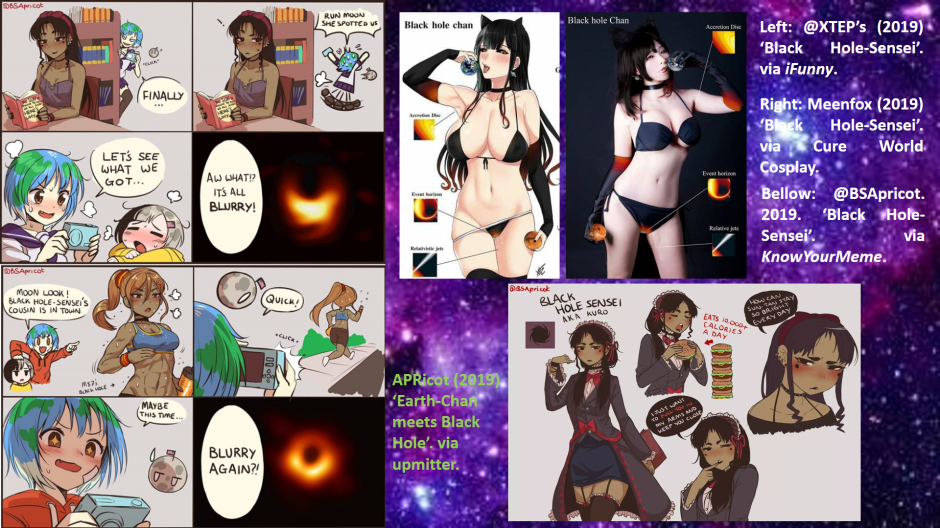
This takes us beyond the works of Holst, into territory he could not have possibly charted. On 10th April 2019, and image was released of a supermassive black hole. Taken by the Event Horizon Telescope using an algorithm developed by Katherine Bouman. The release of this image inspire the creation of Black Hole-Sensei. In the above comic by BSApricot, we see Earth-Chan trying to snap a photo of Black Hole-Sensei, which is a representation of the work by the Event Horizon Telescope to capture an image of the black hole. The punch line is of course the sourcing of the original images of the black holes and referring to them as “blurry”. Earth-Chan complaining about her blurry photography is both credit to Katherine Bouman and the Event Horizon team, but also an awareness that there are still improvements to be made, more to do, and more to learn! In XTEP’s illustrated diagram and cosplayer Meenfox’s replication of this diagram we see parts of Black Hole-Sensei’s body directly compared to attributes of a black hole. This is a sexual performance which is used to humorous effect, whilst somewhat on the nose, its imagery can be a resourceful starting point for discussion. The images generate a scientific interest, not only evoked in the diagram format, but by the fact that we do learn (even if just a little) about the components of a black hole. But I’m not going to leave you stranded here in the depths of space, so let’s return home, back to planet Earth.
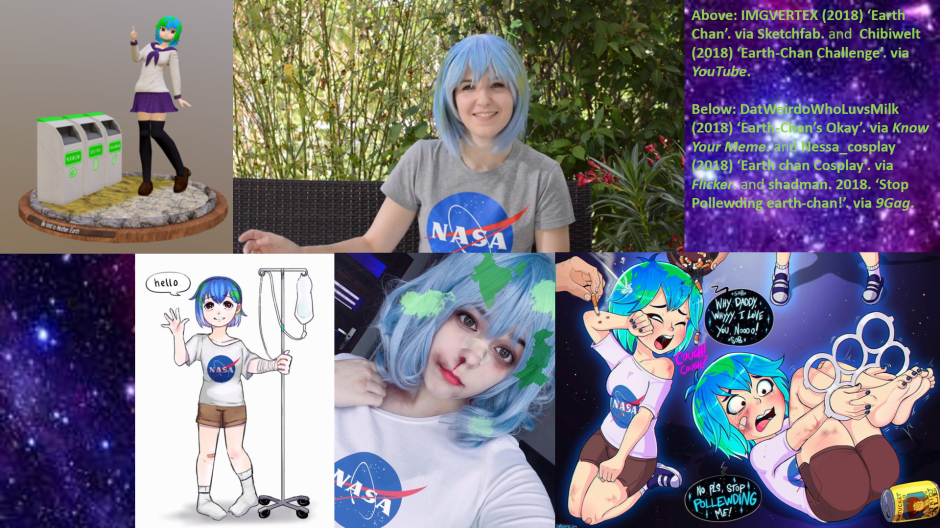
Earth-Chan remains the most popular within this community and she has been used to a number of different effects. Some humorous critiquing flat earth conspiracy theorists; others using the character as jerk-off material because apparently some people literally want to fuck the Earth; but also what I’m most interested in, is how the character has been used as an icon for environmental activism. In IMGVERTEX’s 3D Earth-Chan model, Earth-Chan is seen next to a row of recycle bins, the caption on the model reads “Be kind to Mother Earth”. The message here is pretty clear, to be more considerate about our waste and to encourage us to recycle. The cosplayer Chibiwelt made use of the character in her video series ‘Earth-Chan challenge’, in which, each week Chibiwelt would share different ‘tasks’ designed to encourage audiences to make small changes to their lives and live more environmentally friendly (go vegetarian, use bamboo toothbrushes, buy products which don’t contain palm oil, buy second hand clothes, etc.). Chibiwelts videos are warm and encouraging, her presentation style is friendly, even the outdoor setting creates a natural harmonic atmosphere. On the other hand, there is plenty of art and cosplay which has taken Earth-Chan and placed her in life threatening situations. For example, depicting Earth-Chan wrapped in plastic; buried in rubbish; bruised and beaten up; or critically ill and hooked up to an I.V. line. Such graphic depictions of what was initially intended to be a cutesy character is used precisely to unsettle and unnerve people, drawing attention to the damage we as human beings are doing to the planet. These illustrations and cosplays maintain the cutesy aesthetic, with her big eyes, bright blue hair, and cigarette burns. Yet this is made unsettling by the full length with an I.V., or bruises, cigarette burns. These brutal designs simply depict a beaten child and it’s horrible. As a representation of Earth, the spectator is made to feel responsible for beating up this child. Fan creators highlight our duty or care to the planet, a duty which we are currently avoiding.
Before I leave, as we quickly approach the 50th anniversary of the Apollo 11 moon landing, I thought I’d briefly on Earth-Chan’s sidekick: Moon-Chan. On July 16th 1996, NASA’s Apollo 11 rocket launched for the Moon. With a crew of three, Neil A. Armstrong, Michael Collins, and Edwin E. “Buzz” Aldrin. On 20th July Armstrong and Aldrin made history, landing the Apollo Lunar Module (Eagle) on the Moon’s surface.

The moon has inspired a whole host of myths, art and stories throughout human history. Moon-Chan is Earth-Chan’s sidekick. Moon-Chan is an energetic young girl, she is a loyal friend to Earth-Chan, but worries that some people don’t trust her because of her “dark side”. The Moon is in a synchronized rotation with Earth, as a result we here on Earth (nearly) only ever seen the same side. This is depicted in the characters hair, which shows two sides of the moon (even if it may not be completely accurate as the so called ‘dark side’ is illuminated once every 29.5 Earth days). Moon-Chan’s rain coat in BSApricot’s depiction of Moon-Chan is used firstly to emphases Moon-Chan’s closeness with Earth-Chan (whose “71% water”), but in highlighting this relationship BSApricot draws attention to the moons effect on the Earths tides. The gravitational effects of the moon attract the side of the Earth which is closest to the moon, resulting in the moons influence on Earths tides (again reflected in Moon-Chan’s sidekick status alongside Earth-Chan). And finally, the Moon landing, which is payed tribute in Moon-Chan’s NASA t-shirt.
Now that we’re back home, Holst and Cox have been left to the fate of the Martians, if you haven’t got it already I’d like to conclude by emphasizing that fan practices extend beyond a love of film, TV and games, into the sciences. Or indeed any subject matter, so long as there is that passion and that community driving it. Through fans engagement with astrological objects and bodies, in the anthropomorphisms of the solar system and beyond, fans create accessible narratives which share the discoveries and stories of our planet and our neighboring worlds. It might not be the high art of Holst, but these fans engage with astronomical science and not the mysticism of astrology. Personally, I think that if fan creators can teach us just a little, to look up to the stars, follow the news, create, learn, and love learning; than this is wonderful.